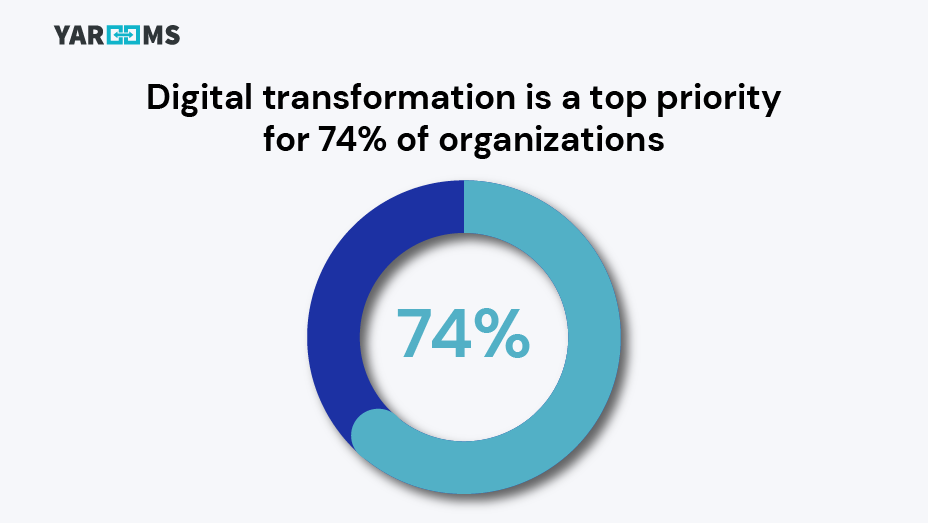Why stay stagnant when the future calls for change?
The digital workplace transformation represents a pivotal shift in how businesses operate, leveraging digital technologies to foster a more efficient, collaborative, and innovative environment. This goes beyond adopting new technologies; it's about a cultural shift toward embracing continuous learning and innovation. Embarking on this digital journey, however, is challenging. Organizations face multiple obstacles, from overcoming resistance to change and financial constraints to ensuring data security.
This article cuts through the complexity of digital workplace transformation, highlighting its essence, significance, benefits, and roadmap to overcoming challenges for a successful transition. Let's uncover how embracing digital transformation can propel organizations toward a future of limitless possibilities!
TL;DR:
- Digital workplace transformation modernizes organizational work environments by integrating digital technologies like cloud services, AI, and mobile solutions, promoting efficiency, collaboration, and innovation.
- This transformation is a cultural shift toward embracing continuous learning and innovation, which is essential for staying competitive in today's rapidly changing business landscape.
- The benefits of embracing digital workplace transformation include increased flexibility, improved communication and collaboration, enhanced information access, operational efficiency, and adaptability.
- Challenges in digital workplace transformation include employee resistance to change, financial constraints, and ensuring data privacy and cybersecurity measures.
- Technological trends like AI, ML, cloud computing, IoT, and comprehensive workplace experience platforms significantly enhance work processes and collaboration.
- Effective change management is essential for a smooth transition to digital workplaces.
Definition and Concept of Digital Workplace Transformation
Digital workplace transformation is the process of modernizing an organization's work environment by embracing digital technologies to enhance efficiency, collaboration, and innovation. It involves moving beyond traditional practices to adopt tools like cloud services, mobile solutions, and artificial intelligence, creating a more flexible and interconnected work experience.
But this shift isn't just about technology—it's a cultural evolution towards continuous learning and innovation, crucial for staying competitive in today's fast-paced world. The move towards digital transformation is driven by the need to adapt to the ever-evolving business landscape, making it essential for organizational success. In short, digital workplace transformation has evolved from a mere choice to a critical imperative. Let's explore the driving forces behind this.

Why Is Digital Workplace Transformation Imperative?
It's simple, really – standing still means getting left behind. In a world synchronized with the rhythm of innovation, organizations must embrace change to stride alongside (or even outrun) their competitors. Staying current with emerging technologies allows businesses to survive and thrive amidst changing market dynamics. Here's how:
- Competitive Advantage: Adopting cutting-edge tools gives companies an edge over competitors lagging in their digital journey.
- Customer Expectations: Users nowadays expect swift responses and real-time interaction; robust digital infrastructures make meeting these needs conceivable.
- Efficiency Boost: Automation can handle repetitive tasks flawlessly, allowing employees to focus on strategic initiatives.
These points only scratch the surface of why investing time and resources into fully embracing a digital workspace has ceased to be optional. So, let's dig deeper and unearth the specific benefits associated with digital workplace transformation.
The Benefits of Digital Workplace Transformation
Transformation always brings about change, and in terms of digital workplace transformation, numerous advantages come with it.
Increased Flexibility and Accessibility
One of the most significant benefits of digital transformation in the workplace is increased flexibility and accessibility. A proper digital workplace enables employees to access tools and information anytime and anywhere. Unlike traditional offices, it does not require being in a specific place or adhering to strict working hours. As a result, employees enjoy better work-life balance and demonstrate more productivity—a win-win scenario for all parties involved.
Improved Communication and Collaboration Among Teams
Digital workplaces also foster superior collaboration among teams by breaking down silos through improved communication channels. Harnessing collaboration technologies like video conferencing software, project management tools, or hybrid work planning calendars can unite teams regardless of their distance. Sharing updates becomes effortless as the information travels faster, leading to quicker decision-making.
Enhanced Information Access and Knowledge Sharing
Digital workplace transformation makes information more accessible and enhances knowledge sharing. With advanced portals or content management systems, crucial data isn't limited within departmental confines but is readily available across teams. Moreover, digital platforms encourage peer-to-peer exchange of expertise, forming a culture of continuous development.
Boosted Overall Operational Efficiency & Cost Savings
Every organization aims to achieve optimal utilization of resources—both human and technical. This is where digital workplace solutions shine brightest: streamlining operations saves time, which leads to substantial cost savings. Digitizing mundane tasks and automating routine functions (for example, workspace booking) free up employees' time to focus on more strategic, revenue-generating initiatives.
Better Adaptability to Technological Advancements and Market Demands
Finally, adapting swiftly and effectively to technological advancements becomes feasible when businesses have transitioned into a digital workplace. Future-facing companies consider this transformation not just an operational shift but essentially the foundation of their ability to remain competitive in the market by quickly responding to its dynamic demands.

Challenges and Barriers in Digital Workplace Transformation
The road to digital workplace transformation is often paved with challenges that require thoughtful strategies to overcome. The roadblocks vary from organization to organization but generally fall under a few common categories.
Employee Resistance to Change and Adoption
Half of business leaders reveal that the top challenge for digital transformation is employees' resistance to change, while half of employees are concerned about their lack of technology skills.
Employee resistance to workplace change often stems from fear—fear of the unfamiliar, fear of losing control over known tasks, or even the fear of obsolescence. Implementing new technological systems and processes can indeed be overwhelming for employees, who may view them as threats rather than opportunities for growth and efficiency.
As a workplace digital transformation lead, your responsibility is to address this fear by fostering an environment of support, education, and engagement. This ensures that the transition is seen not as a threat but an invaluable opportunity for growth and efficiency.
Financial Barriers to Implementation Success
Mid-sized companies with revenue under $1 billion often struggle with budget constraints, making it difficult to cover the costs of digital transformation efforts. Moreover, for 28% of companies, digital transformation is seen as a cost center, indicating challenges in proving ROI and justifying financial investments in digital initiatives.
Indeed, financial constraints are a significant roadblock to initiating workplace digital transformation. Incurring costs associated with acquiring necessary technology, training personnel on how to use it effectively, and ongoing maintenance expenses all congregate into formidable expenses that contribute to financial barriers restricting the smooth transition into digitally adept workplaces.
Ensuring Data Privacy and Cybersecurity Measures
Digital transformation is a top priority for 74% of organizations, surpassing cybersecurity and cloud implementation. Ironically, ensuring data privacy and cybersecurity measures is one of the critical challenges on the road to digital workplace transformation. Why?
Digital workplace transformations invite potential cyber vulnerabilities requiring immediate attention at different levels: corporate information getting leaked out, either deliberately or accidentally, via unsecured networks and sensitive data falling prey to sophisticated hacking attempts are just instances indicating graver implications at play.
Given these significant risks, it is crucial to underscore the importance of ensuring robust IT security measures to protect against such vulnerabilities, safeguard sensitive information, and maintain the integrity of digital workplaces.

Strategies for a Successful Digital Workplace Transformation
Digital workplace transformation can be a significant undertaking, but having an effective strategy can make the process smoother and more manageable.
Assessing the Need for Change in Your Current Workplace Setup
Before jumping into implementing any transformation, taking a step back and evaluating the need for change in your current setup is crucial. This initial assessment involves acknowledging limitations in your existing systems and determining areas where technology could enhance productivity or operations.
Examine pain points that people in your organization often face—from communication hiccups to data management issues. Then, compare them with potential improvements resulting from successful digital transformation initiatives. By mapping these out clearly, you'll have the concrete reasons driving this venture, making its necessity evident to everyone involved.

Crafting a Clear Vision and Strategy for Transformation
Once you've identified areas needing improvement, create a clear vision outlining what you wish to achieve with this digital transformation effort. When crafting this vision, keep both long-term goals and short-term expectations aligned with realistic timelines and outcomes.
Be sure that every part of your strategy addresses how transformations impact every facet—from enhancing daily operational tasks using technological advancements to redefining customer engagement techniques via upgraded digital channels.
Identifying Barriers to Transformation and How to Overcome Them
Regardless of your endeavors toward digital workplace transformations, challenges are inevitable. As discussed earlier, these barriers might present themselves as technological hurdles, organizational resistance, or logistical obstacles. Here’s how you can efficiently tackle these issues:
- Identify relevant stakeholders crucial in decision-making processes
- Address employee resistance by reinforcing the benefits they stand to gain from these changes
- Offer sufficient training programs for transitioning to newer systems
- Implement user-friendly digital tools that simplify rather than complicate workflows
Only by proactively addressing these barriers can you successfully maneuver around them and pave the way for successful implementation.
Leveraging Collaborative Tools and Technologies Effectively
The goal of any digital workplace transformation is trifold: increasing efficiency, fostering innovation, and facilitating seamless collaboration. To achieve this, you might be tempted to implement a full suite of digital solutions all at once. However, more isn't always better.
Deploying too many technologies or tools simultaneously may confuse or overwhelm employees, potentially slowing down adoption rates. Therefore, an effective combination of just the right number of collaborative tools incorporated gradually will yield the most positive results.
Promoting Employee Engagement and Feedback Channels
Regardless of how bulletproof your plans seem, real-time adjustments would be challenging without sufficient employee engagement and feedback channels. Creating spaces for regular check-ins and discussions helps everyone feel heard during this transformative journey.
Feedback from those using new systems daily provides invaluable insights into what's working well and what needs further tweaking. Keeping dialogue channels open fosters a community sense within your organization—empowering individuals while bringing about collective growth amidst workplace transformations.
Technological Aspects & Trends in Digital Workplace Transformation
Technology is crucial in successfully transforming workplaces. At the heart of this transformation are digital tools that improve work processes, enhance collaboration, and boost business efficiency.
The introduction of Artificial Intelligence (AI) and Machine Learning (ML) expands possibilities, streamlining tasks, forecasting trends, enhancing cybersecurity, and personalizing employee experiences. By 2023, 60% of major businesses are expected to use AI and ML to improve the employee experience from start to finish.

Cloud Computing is vital for its scalability, reliability, and data storage, making workplaces more flexible and accessible. The Internet of Things (IoT) further enables smart workplaces through better connectivity and automation, improving efficiency.
Communication and collaboration tools, like project management software and platforms such as Slack or Microsoft Teams, bridge distances and enable real-time project cooperation. Mobile technology provides access to crucial data anywhere, fostering an always-connected workforce.
A significant addition to these technologies is the emergence of comprehensive workplace experience platforms. These platforms consolidate various functionalities—from space booking and hybrid work planning to visitor management—into one tool, streamlining operations and enhancing the overall workplace experience.
However, adopting these technologies is not enough. They need to be integrated into workflows and matched to the technological skills of the workforce. The challenge is not just possessing advanced tools but using them effectively in alignment with organizational goals.
Adopting technology requires balancing innovation with practical business needs and ensuring employee support for lasting success. So, let’s explore how to manage change if you want an efficient digital workplace!
Change Management in Digital Workplace Transformation
Steering the ship towards a digital workplace transformation is not only about integrating advanced technology into your workflows. It's equally, or even more, important to focus on helping your employees adjust to these changes. A good change management strategy covers everything - getting your team ready for new systems and ensuring they can smoothly transition to using them.
Set Clear Expectations
First and foremost, setting transparent expectations with your team is a vital step. Lay out the changes, the projected timeline, and the employee role within this journey. With clear goals in sight, resistance toward change can dramatically lessen.
Keep Stakeholders Engaged
It's also necessary to maintain everyone's engagement throughout the digital transformation. One way to achieve this could be to assign key stakeholders ownership over certain aspects of the project, empowering them with decision-making authority.
Provide Adequate Training
Another critical aspect is training for mastery—not just surface-level familiarity—of new digital tools and procedures. Offer comprehensive training programs that are both structured (for instance, workshop sessions) and flexible (such as on-demand online tutorials).
Offer Continuous Support
Remember, support shouldn't stop at deployment. Changes often need refinements post-implementation based on user feedback or unforeseen challenges that become apparent only after actual use begins. Creating a robust network for ongoing technical assistance during and after the transition phase is essential.
The bottom line? Embracing digital workplace transformation involves much more than merely deploying new technologies—it also requires deft handling of the human element! Only then can we hope for a smooth voyage towards a high-performing digital world at work.
Measuring Success and Key Performance Indicators (KPIs) in Digital Workplace Transformation
Digital workplace transformation becomes more manageable once you identify the right performance metrics. These Key Performance Indicators (KPIs) allow you to track the progress of your digital transformation efforts, ensuring they align with established objectives.
Setting effective KPIs depends significantly on your goals for implementing digital workplace solutions. For example, if your goal is to improve your office space utilization, measuring things like meeting room occupancy rates or desk booking frequency can be valuable indicators of success.

Essential KPIs for Your Digital Workplace Strategy
Incorporating robust KPI collection mechanisms into your digital workplace platform can greatly enable data-driven decision-making. Here are some broad categories of KPIs that might matter to your organization:
- Usage statistics: monitor the adoption rates of new tools and applications by tracking how often employees use them.
- Employee engagement: use surveys or feedback forms to measure employee satisfaction levels with the transformed work environment.
- Productivity: analyze task completion times pre- and post-transformation.
However, each company will have unique KPIs based on individual needs during its journey towards total workplace transformation.
You must remember that setting up realistic and relevant KPIs is not a one-time activity. It requires continuous iterative refinements reflecting changes in business processes, technology improvements, and other environmental factors impacting organizational functioning.
Summing Up: Ensuring Long-Term Success in Digital Workplace Transformation
The journey to digital workplace transformation is multifaceted, requiring not just the adoption of cutting-edge technology but also visionary leadership, strategic execution, and ongoing employee engagement. Organizations must adopt a systematic and organized approach to navigate this transition effectively.
To ensure long-term success, treat digital transformation in the workplace as an ongoing effort rather than a one-off project. We cannot emphasize enough the importance of meeting evolving customer expectations, emerging technologies, and market trends. Keep experimenting, learning, and improving!












